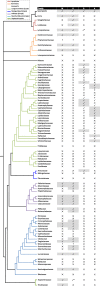The distribution and evolution of fungal symbioses in ancient lineages of land plants
- PMID: 32130512
- PMCID: PMC7062687
- DOI: 10.1007/s00572-020-00938-y
The distribution and evolution of fungal symbioses in ancient lineages of land plants
Abstract
An accurate understanding of the diversity and distribution of fungal symbioses in land plants is essential for mycorrhizal research. Here we update the seminal work of Wang and Qiu (Mycorrhiza 16:299-363, 2006) with a long-overdue focus on early-diverging land plant lineages, which were considerably under-represented in their survey, by examining the published literature to compile data on the status of fungal symbioses in liverworts, hornworts and lycophytes. Our survey combines data from 84 publications, including recent, post-2006, reports of Mucoromycotina associations in these lineages, to produce a list of at least 591 species with known fungal symbiosis status, 180 of which were included in Wang and Qiu (Mycorrhiza 16:299-363, 2006). Using this up-to-date compilation, we estimate that fewer than 30% of liverwort species engage in symbiosis with fungi belonging to all three mycorrhizal phyla, Mucoromycota, Basidiomycota and Ascomycota, with the last being the most widespread (17%). Fungal symbioses in hornworts (78%) and lycophytes (up to 100%) appear to be more common but involve only members of the two Mucoromycota subphyla Mucoromycotina and Glomeromycotina, with Glomeromycotina prevailing in both plant groups. Our fungal symbiosis occurrence estimates are considerably more conservative than those published previously, but they too may represent overestimates due to currently unavoidable assumptions.
Keywords: Arbuscular mycorrhizas; Ericoid mycorrhizas; Hornworts; Liverworts; Lycophytes; Mucoromycota.
Conflict of interest statement
The authors declare that they have no competing interests.
Figures

References
-
- Adams DG, Duggan PS. Cyanobacteria-bryophyte symbioses. J Exp Bot. 2008;59:1047–1058. - PubMed
-
- Brundrett MC. Mycorrhizal associations and other means of nutrition of vascular plants: understanding the global diversity of host plants by resolving conflicting information and developing reliable means of diagnosis. Plant Soil. 2009;320:37–77.
-
- Brundrett MC, Tedersoo L. Evolutionary history of mycorrhizal symbioses and global host plant diversity. New Phytol. 2018;220:1108–1115. - PubMed
Publication types
MeSH terms
Grants and funding
LinkOut - more resources
Full Text Sources

